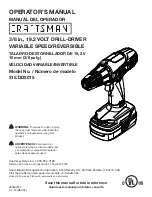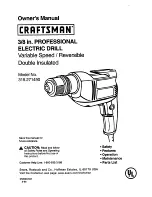
35
EnGLIsh
Forward/Reverse Control Button (Fig. F)
A forward/reverse control button
4
determines the direction of
bit rotation and also serves as a lock‑off button.
To select forward rotation,
release the trigger switch
3
and
depress the forward/reverse control button on the right side of
the tool.
To select reverse,
depress the forward/reverse control button
on the left side of the tool.
The center position of the control button locks the tool in
the off position.
When changing the position of the control
button, be sure the trigger is released.
nOTE:
The first time the tool is run after changing the direction
of rotation, you may hear a click on start up. This is normal and
does not indicate a problem.
Trigger Switch (Fig. A)
To turn the tool on, squeeze the trigger switch
3
. To turn the
tool off, release the trigger switch. Your tool is equipped with
a brake. The chuck will stop as soon as the trigger switch is
fully released.
Variable Speed Trigger Switch
The variable speed trigger switch enables you to select the best
speed for a particular application. The farther you squeeze the
trigger switch, the faster the tool will operate. For maximum tool
life, use variable speed only for starting holes or fasteners.
nOTE:
Continuous use in variable speed range is not
recommended. It may damage the trigger switch and should
be avoided.
Proper Hand Position (Fig. E)
WARNING:
To reduce the risk of serious personal injury,
ALWAYS
use proper hand position as shown.
WARNING:
To reduce the risk of serious personal
injury,
ALWAYS
hold securely in anticipation of a
sudden reaction.
Proper hand position requires one hand on the side handle
1
,
with the other hand on the main handle
6
.
OPERATION
Instructions for Use
WARNING:
Always observe the safety instructions and
applicable regulations.
WARNING:
To reduce the risk of serious personal
injury, turn tool off and disconnect battery pack
before making any adjustments or removing/
installing attachments or accessories.
An accidental
start-up can cause injury.
Bit and Bit Holder
WARNING:
Burn Hazard.
ALWAYS
wear gloves when
changing bits. Accessible metal parts on the tool and bits
may get extremely hot during operation. Small bits of
broken material may damage bare hands.
The hammerdrill can be fitted with different bits depending on
the desired application.
Use sharp drill bits only.
Bit Reccomendations
• For wood, use twist bits, spade bits, power auger bits or
hole saws.
• For metal, use high‑speed steel twist drill bits or hole saws.
Use a cutting lubricant when drilling metals. The exceptions
are cast iron and brass which should be drilled dry.
SDS plus® Bit Holder (Fig. H)
nOTE:
Special adapters are needed to use the SDS plus® bit
holder with straight shank bits and hexagonal screwdriver bits.
Refer to
Optional Accessories
.
To insert a drill bit or other accessory:
1. Insert the shank of the bit about 19 mm into SDS plus® tool
holder
15
.
2. Push and rotate bit until it locks in place. The bit will be
securely held.
3. To release bit, pull the sleeve
16
back and remove the bit.
Utility Hook (Fig. D)
WARNING: To reduce the risk of serious personal
injury, ONLY use the tool’s ultilty hook to hang the
tool from a work belt. DO NOT use the ultilty hook
for tethering or securing the tool to a person or
object during use. DO NOT suspend tool overhead or
suspend objects from the ultilty hook.
WARNING: To reduce the risk of serious personal
injury, ensure the screw holding the ultilty hook
is secure.
IMPORTanT:
When attaching or replacing the ultilty hook
10
,
use only the screw
14
that is provided. Be sure to securely
tighten the screw.
The ultilty hook can be be attached to either side of the tool
using only the screw provided, to accommodate left‑ or right‑
handed users. If the hook is not desired at all, it can be removed
from the tool.
To move ultilty hook, remove the screw that holds the ultilty
hook in place then reassemble on the opposite side. Be sure to
securely tighten the screw.
grip of the side handle clockwise. The side handle must be
tightened sufficiently to resist the twisting action of the tool if
the accessory bind or stall. Be sure you moved the side handle
against the end of the collar end to have the clamping piece
fully engaged.
To Adjust the Depth Rod (Fig. A)
Loosen the side handle
1
and move the depth rod
2
so that
the distance between the end of the rod and the end of the bit
equals the desired drilling depth. When drilling with depth rod,
stop when end of rod reaches surface of material.
Summary of Contents for XR DCH072
Page 1: ...DCH072 ...
Page 3: ...1 Fig A Fig B 12 9 8 XXXX XX XX 11 9 8 8 9 10 6 3 4 5 1 2 7 ...
Page 4: ...2 Fig C Fig E Fig G Fig D Fig F Fig H 14 10 4 5 16 15 13 1 6 1 3 ...
Page 5: ...3 Fig I ...
Page 154: ......
Page 155: ......















































